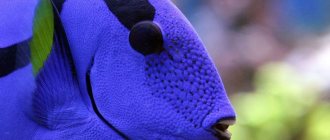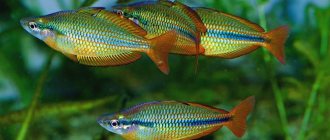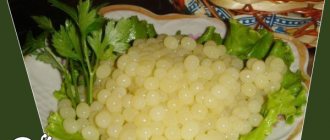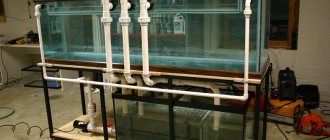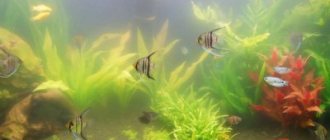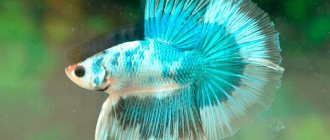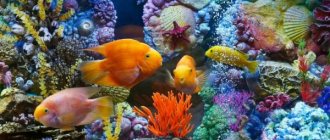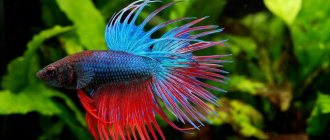Fish pond
To breed fish, in particular crucian carp, you can use a natural or artificial reservoir equipped in your backyard. The most optimal pond size is 6x6 meters, with a depth of at least one meter. For breeding heat-loving species, such as carp, the optimal depth is 2 meters, and for fish that require only cool water, such as trout and sturgeon, 3 meters or more. Part of the coastal zone needs to be made shallow, since in the spring the water in these areas warms up better and fish spawn there.
After arranging the reservoir, the first step is to strengthen the bank so that the soil does not slide into the water during precipitation. To do this, you can sow the edge of the bank with grass, which will strengthen the soil well. The bottom also needs to be planted with vegetation necessary for the nutrition of fish and for the life of microorganisms. You can take algae from any natural body of water.
Types of pike
Today there are several types of pike - these are the common, Amur, American, Aquitanian, southern, black and musky. They all differ not only in color, but also in size and habitat.
Common pike
The most typical representative is the common pike, which lives in the waters of North America and Eurasian countries. The weight of individuals reaches 8 kg, length – up to one and a half meters. There is no characteristic color; it varies depending on the main habitat. There are fish that have a gray-yellow, brown, and also gray-green tint. Representatives of this species prefer coastal parts of rivers and lakes, waters without running currents, and places with abundant thickets.
American pike
This is a species of redfin pike that is common in the waters of North America. There are two subspecies - southern and northern pike, the habitat of this predator is in some rivers flowing into the Atlantic Ocean in the Mississippi. The maximum length of individuals is up to 35-40 kg, weight rarely exceeds 1 kg. Distinctive external features include a shortened snout and red fins for the northern subspecies. Lifespan is about 10 years.
muskellunge pike
A rather rare species, it is distinguished by its large size - some specimens reach 1.8 m in length and weigh up to 32 kg. In addition to size, pike has a characteristic appearance and coloring. There are vertical stripes or spots on the back. The color of the body is green, silver, brownish-brown.
Amur pike
This species is distinguished by very small scales with a golden-greenish or silvery tint. The general color is unusual; characteristic features include black-brown spots scattered throughout the body. An adult can reach 1.15 m in length and weigh up to 20 kg. The main inhabited area is the Amur River and the reservoirs of Sakhalin. Life expectancy is long - on average reaches 14 years.
Southern or grass pike
This species was identified as a separate species in 2011; previously it was considered one of the subspecies of common pike. The main habitat is Northern and Central Italy.
Black pike
The species is widespread in North America and inhabits vegetated rivers and reservoirs, ranging from southern Canada to Mississippi, the Great Lakes and Florida. The weight of an adult reaches 2 kg, body length is about 60 cm. Externally, this type of pike is similar to the usual one, but there are also differences in color. Characteristic features are a dark stripe that is located above the eyes and an interesting mosaic pattern on the sides of the body.
Aquitaine pike
This species is relatively young, it was described only in 2014. The main habitat is the reservoirs of France, where this particular pike is found in almost all reservoirs.
Fish farming
It is better for novice fish farmers to breed carp, since it is the fastest growing fish, which is suitable for most bodies of water. In addition, it is not very demanding in terms of maintenance conditions, has very high taste qualities and is much easier to sell in retail outlets.
Carp is an unpretentious and omnivorous fish, but if the water temperature drops below 8°C, it practically stops feeding and growing accordingly. The most optimal water temperature is 20 - 29°C. Active weight gain of carp occurs from April to October.
Nutrition
Fry prefer food in the form of microorganisms and plankton, but only until a certain period. As the young grow older, they move on to the fry of other fish, gradually demonstrating their predatory abilities and developing them. The diet consists exclusively of other, smaller fish. The most attractive to this predator are roach, crucian carp, rudd, bleak, perch and others belonging to the carp family. Pike avoid unfamiliar fish, preferring to hunt familiar species.
Three to four times a year, pike have a glutton, most often before breeding. This is September-October and May-July, however, the timing is tentative and depends on many factors, including weather and breeding conditions.
Where to buy fry?
To stock a pond, fry can be purchased at fish farms or a special store. As a rule, fish fry begin to be sold in the spring after the ice breaks up. You can purchase one-year-olds weighing 50–70 g, or two-year-olds weighing 200–250 g. When purchasing, you need to take into account some factors that will affect the survival rate of the fry in the place where they settle. First of all, try to find out as much as possible about this fish farm, how long has it been operating? How often do pond fry get sick and what do they do? Does the farm have a license for this type of activity? If possible, find and talk to regular customers. You also need to visit the selected farm and see in what conditions the fish fry are kept. This important information will help to avoid significant losses of planting material during transportation and settlement in the reservoir.
Approximate calculation of the growth of carp fry for the season (from April to October):
- Carp fry weighing 20 g can gain weight up to 250 g.
- Planting material (50 – 70 g) – up to 700 g.
- The fish gains 200 - 250 g per season, up to 1000 - 1200 g.
As you can see, the fish grows quite quickly, so it can bring good income.
Features of anatomy and appearance
Pike is rightfully considered the most voracious predator of fresh water bodies. This fish prefers a sedentary, hidden lifestyle, while it hunts from ambush, watching for its prey from close range. However, during the feeding season, the predator comes out of hiding, changing tactics and actively moving around its lands. If a potential prey is detected nearby, the pike begins an aggressive pursuit and attacks when the opportunity arises.
Structure
The predator has a characteristic structure - an elongated, almost cylindrical body and single fins attached to the tail. This anatomy allows the fish to develop very high speed, quickly overtaking its prey. The plumage of the body is well developed and has a round or oar-shaped shape. This also has a positive effect on hydrodynamics, making the predator very mobile and quite dangerous for other inhabitants of water bodies. Additional protection is provided by the dense cover of the scales, creating an almost monolithic surface invulnerable to other predators.
Vision, sensory organs, skull structure
The predator is distinguished by a wedge-shaped, flattened snout, which provides the fish with frontal vision. This makes it possible to search for prey and estimate the speed and distance to the potential victim. Highly located eyes and a special structure of the head allow the pike to fully view the water area not only around itself, but also to see the surface and deep layers.
The viewing angle is greatly reduced due to the wide-open mouth. That is, the fish cannot see the target that is directly in front of it. That is why experienced fishermen try not to push the bait to the bottom, as the pike simply will not notice it.
The fish has good hearing, it can navigate perfectly in muddy water, picking up the slightest vibrations even at a great distance. The elongated snout provides a significant capture area, which increases the success of hunting other pond inhabitants. The special structure of the gills, the membranes of which are separated from each other, helps the pike open its mouth wide.
Teeth
The fish has developed jaws with a large number of sharp teeth and fangs of various sizes. Also on the palate and tongue there are bristle teeth, which are needle-like formations and a special cover of hard villi. Since the fish does not chew its prey, it needs such a cover to hold it. The predator's main weapon is its teeth, with which it can cause serious injuries to an angler who does not know how to handle this fish.
One of the features of pike is the replacement of damaged or old teeth. It is constant, not periodic, while the pike continues to actively hunt. After spawning, the bite may temporarily decrease, but this does not indicate a period of teeth change, but the exhaustion of the fish.
Color
The pike has a characteristic camouflage coloration of the body, which allows it to successfully hide in the thickets, lying in wait for prey. Throughout the entire theme, except for the belly area, there are transverse stripes of light color and spots reminiscent of camouflage colors. This is ideal for fish that prefer to hunt in areas where snags and dense vegetation accumulate. Juveniles are lighter in color; in adults, the color becomes richer and darker. The most common color is gray-white and light yellow, the belly is speckled with stripes and light stains.
Transportation of fry
Fish fry are transported in sealed containers. Most often, 50 liter barrels with a wide neck are used.
When transporting fish, it is recommended to take water for it from the same reservoir where it was previously located, since water from wells, boreholes and water pipes is not suitable, as it has a low oxygen content.
In hot weather it is better not to transport the fry. The best time for transportation is early morning or evening. Before fish fry are released into the pond, it is necessary to equalize the temperature in the containers so that it is equal to the temperature of the pond water. If the difference is more than 2 degrees, the fry may experience temperature shock. To do this, you need to gradually add colder water from the reservoir to the container where the carp fry are located until their temperatures are equalized. After this, you can safely release the “new settlers” into the pond for further cultivation.
Habitat
Habitat: freshwater ponds, lakes and rivers of Eurasia and North America. Relatively calm bodies of water with stagnant water, thickets, bottom moss and snags are preferable. The fish leads a sedentary life, preferring places with holes and dense coastal vegetation, where active hunting can be carried out. In rare cases, this predator can be found in desalinated waters near the sea coast, for example, in the Gulf of Riga or the Gulf of Finland, near the Baltic Sea.
In ponds and lakes, fish prefer to stay close to the shore, in algae thickets or in fairly littered shallow water. In a river, the predator can be not only in the coastal zone, but also at depth, preferring mouths that flow into reservoirs. The predator feels quite comfortable in ponds with a high oxygen content, which protects it from death when the water level drops in winter. Pike tolerates acidified water well, which allows it to live in swampy areas. But she avoids rocky rivers with fast currents.
The main condition is abundant vegetation, the presence of snags or stumps, holes where a predator can lie in wait for prey. In an ambush, the fish sits motionless, but rushes towards the target quickly. The special shape of the body allows the predator to move very quickly and jump to great heights. But she can only swallow her prey from the head.
Food for carp breeding
Carps mainly feed on plant foods, as well as small aquatic organisms and insects. This fish especially loves young shoots of cattails and reeds. But in order for it to grow well and gain weight, it must be fed with special feed (preferably granulated). For each age, the appropriate compound feed is sold, having a certain granule size. You can also feed the fish with wheat grain (preferably slightly sprouted). It has a sweet taste, carp eat it well and gain weight very quickly.
For better fish growth, you can install a fly larvae cultivator in the pond, which will provide the fish with free, complete protein food. Carps with such installed cultivators grow faster.
You can also attract insects by using light traps. They are the most ordinary lamps with a lampshade. They are suspended above the water at a meter height and turned on at night. Light strongly attracts various insects - butterflies, mosquitoes, beetles. They fly into the light and, burning themselves on a heated light bulb, fall into the water, where they are eaten by fish.
It must be remembered that when feeding carp with compound feed, you must not overdo it. The fish must eat the food completely. If there is too much of it left, it will turn sour, which will dramatically deteriorate the quality of the water in the pond.
It is recommended to serve food to carp in feeders, since this makes it much easier to control the amount consumed by the fish.
Spawning, offspring of pike
Spawning begins immediately after the ice melts at a temperature of 3-6 degrees Celsius. The depth depends on the terrain and can be 15-1000 meters. During spawning, the fish rises to the surface and enters shallow water, where it begins to splash noisily.
Under natural conditions, the ability to reproduce occurs by the age of 4 in males and 5 in females. Small pikes spawn first, then only large ones, females go ahead of males. When breeding, the fish begins to rub against stumps and snags, reed stems, grass, spawning. The flock does not stay long at the spawning ground, leaving for a new place. It is very important that during this period there is no decline in water, as there is a high risk of death of the eggs. This phenomenon is often observed when water is released into reservoirs.
The fry acquire the ability to hunt when they reach a body length of 12-15 mm. Usually, carp fry are used as food, since this fish spawns immediately after pike. After young individuals reach a length of 5 cm, they completely switch to independent feeding on other small fish.
In the spring, young animals usually settle in floodplain ponds. After the connection between lakes and rivers is broken, the lifestyle of such pikes is very different from those that remained in large lakes or rivers. With a lack of nutrition, the size of individuals is approximately 2-2.5 times smaller, and the phenomenon of cannibalism is observed, that is, larger predators begin to actively hunt smaller ones.
Growing equipment
You can provide conditions suitable for growing trout at home using:
- a gas generator that fills the water with oxygen and ozone;
- pumps for water circulation;
- cleaning filters;
- automatic feeding systems;
- devices for determining the level of acidity and chlorine in a reservoir.
If you plan to grow fish from eggs and fry, additional incubation equipment is purchased. Buckets and nets are also needed to catch and move trout.
When using a RAS, most of the equipment will not have to be purchased separately.
Disease Prevention
If one of the fish shows signs of illness, it should be moved from the rest to a separate container and its health condition monitored. To reduce the risk of disease, you should use fresh food that does not contain cottonseed cake, periodically check the condition of the water, and do not keep young and adult individuals together.
For infectious diseases, characteristic signs are:
- change in scale color;
- slow movements;
- reduced feeding requirements.
When purchasing fry or young fish, it is not recommended to release them to existing individuals. It is necessary to keep her in quarantine for some time to make sure there are no diseases.
What kind of trout should I breed?
There are about 20 species of trout. But you can grow a smaller part of them at home. Keeping trout is difficult because it is a predatory type of fish. Therefore, before breeding it at home, you need to make sure that you have enough finances for feeding.
Each type of trout has its own preferences for keeping. It is necessary to decide in advance which of them will be bred in order to organize suitable conditions.
Rainbow trout (mykiss), brook or lake trout (or brown trout), Eisenam trout, Arctic char and smallmouth are listed in the Red Book, therefore their keeping is prohibited by law (Criminal Code of the Russian Federation, Article 258.1).
Rainbow
Rainbow trout are native to North America. It is accustomed to cold temperatures, but grows better in warm conditions. It is recommended to keep rainbow trout at temperatures between 16 and 18 degrees Celsius above zero. This type has a number of advantages:
- fry weigh no more than 30 grams, making them easier to keep at a young age;
- in just a year, fish can grow up to 125 grams;
- young females can bring up to 800 eggs.
The disadvantage of rainbow trout is that sexual maturity in representatives of this species occurs at the age of about three years. For this reason, in the first years it is impossible to breed trout.
Males can be identified by their wide iridescent stripes. It appears during puberty. For trout farming, it is recommended to keep females until they become adults. At this age they are able to produce up to 3 thousand eggs. The birth of fry occurs in the spring.
Ruchevaya
Brown trout grow slower than rainbow trout and produce fewer offspring. In the first year, young fish reach a weight of only 25 grams. For a trout to weigh 500 grams, it must be at least 3 years old.
Benefits of brook trout include:
- adult fish reaches a weight of 12 kilograms;
- the female is capable of producing up to 1500 eggs;
- The diameter of one egg is only 7 millimeters, so storing them does not require much space.
Sexual maturity in brook trout occurs at the age of 3 years. By increasing the temperature to +8 degrees Celsius, the incubation period can be reduced to 65 days. If the eggs are stored in water at a temperature of +2 degrees Celsius, the incubation period will take about two hundred days. Young fish are born in autumn.
Useful properties of meat
Pike meat has many beneficial properties, including dietary ones. The calorie content is low and the fat content is also low. At the same time, the amount of nutrients and microelements is quite rich, that is, pike meat can be classified as the most useful variety. The composition includes natural antiseptics, which reduce the likelihood of contracting bacterial infections and increase immunity. Many experts recommend including pike meat as a preventive measure during periods of active flu incidence.
Meat is very useful for those who suffer from cardiovascular diseases, hypovitaminosis, and gastrointestinal problems. The composition includes potassium, phosphorus, B vitamins; with regular consumption of pike meat, it is possible to reduce the risk of developing arrhythmia and effectively fight excess weight.
